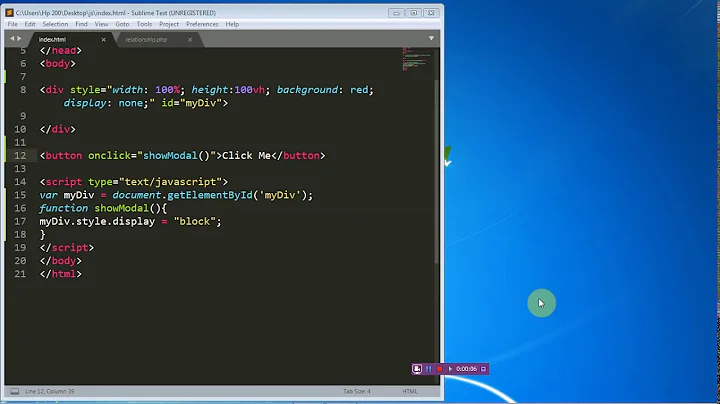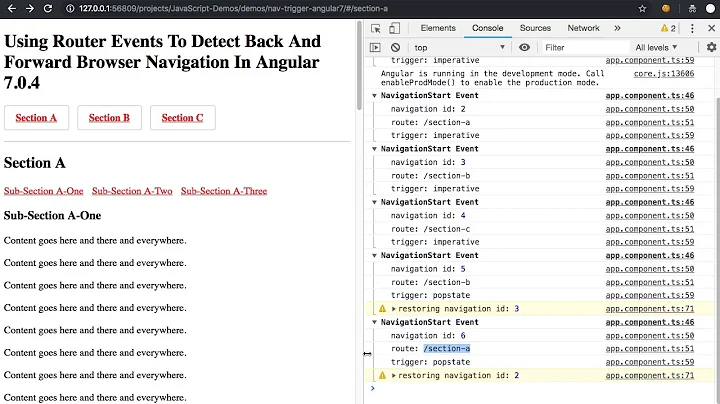Angular 2 How to detect back button press using router and location.go()?
Solution 1
I don't know if the other answers are dated, but neither of them worked well for me in Angular 7. What I did was add an Angular event listener by importing it into my component:
import { HostListener } from '@angular/core';
and then listening for popstate on the window object (as Adrian recommended):
@HostListener('window:popstate', ['$event'])
onPopState(event) {
console.log('Back button pressed');
}
This worked for me.
Solution 2
Another alternative for this issue would be to subscribe to the events emitted by the Angular Router service. Since we are dealing with routing, it seems to me that using Router events makes more sense.
constructor(router: Router) {
router.events
.subscribe((event: NavigationStart) => {
if (event.navigationTrigger === 'popstate') {
// Perform actions
}
});
}
I would like to note that popstate happens when pressing back and forward on the browser. So in order to do this efficiently, you would have to find a way to determine which one is occurring. For me, that was just using the event object of type NavigationStart which gives information about where the user is coming from and where they are going to.
Solution 3
To detect browser back button click import platformlocation from '@angular/common and place the below code in your constructor :
constructor(location: PlatformLocation) {
location.onPopState(() => {
alert(window.location);
}); }
Solution 4
Angular documentation states directly in PlatformLocation class...
- This class should not be used directly by an application developer.
I used LocationStrategy in the constructor
constructor(location: LocationStrategy) {
location.onPopState(() => {
alert(window.location);
});
}
Solution 5
A great clean way is to import 'fromEvent' from rxjs and use it this way.
fromEvent(window, 'popstate')
.subscribe((e) => {
console.log(e, 'back button');
});
Related videos on Youtube
Adrian Moisa
Tech Lead, Project Manager, Founder at Qualia Vision
Updated on July 30, 2022Comments
-
 Adrian Moisa almost 2 years
Adrian Moisa almost 2 yearsI have built an app that uses
router 3.0.0-beta.1to switch between app sections. I also uselocation.go()to emulate the switch between subsections of the same page. I used<base href="/">and a few URL rewrite rules in order to redirect all routes toindex.htmlin case of page refresh. This allows the router to receive the requested subsection as a URL param. Basically I have managed to avoid using theHashLocationStrategy.routes.ts
export const routes: RouterConfig = [ { path: '', redirectTo: '/catalog', pathMatch: 'full' }, { path: 'catalog', component: CatalogComponent }, { path: 'catalog/:topCategory', component: CatalogComponent }, { path: 'summary', component: SummaryComponent } ];If I click on a subsection in the navigation bar 2 things happen:
-
logation.go()updates the URL with the necessary string in order to indicate the current subsection - A custom
scrollTo()animation scrolls the page at the top of the requested subsection.
If I refresh the page I am using the previously defined route and extract the necessary parameter to restore scroll to the requested subsection.
this._activatedRoute.params .map(params => params['topCategory']) .subscribe(topCategory => { if (typeof topCategory !== 'undefined' && topCategory !== null ) { self.UiState.startArrowWasDismised = true; self.UiState.selectedTopCategory = topCategory; } });All works fine except when I click the back button. If previous page was a different section, the app router behaves as expected. However if the previous page/url was a subsection, the url changes to the previous one, but nothing happens in the UI. How can I detect if the back button was pressed in order to invoke the
scrollTo()function to do it's job again?Most answers I saw relly on the event
onhashchange, but this event does not get fired in my app since I have no hash in the URL afterall...-
Aderbal Nunes almost 7 years
-
-
 Christophe Gigax almost 7 yearsThe problem with onPopState is that the event is raised even if the user go forward.
Christophe Gigax almost 7 yearsThe problem with onPopState is that the event is raised even if the user go forward. -
Raul A. almost 6 yearsThis creates a global listener for the
window:popstateevent while using@HostListenerwill only listen when on the current component. -
 Joshua JLIVE Williams over 5 yearshow do you stop listening to events or unsubscribe from this event. i tried using fromEvent(window, 'popstate') and unsubscribing there but it didnt work.
Joshua JLIVE Williams over 5 yearshow do you stop listening to events or unsubscribe from this event. i tried using fromEvent(window, 'popstate') and unsubscribing there but it didnt work. -
 Ben Taliadoros over 5 yearsyou could do location.onPopState = () => {}
Ben Taliadoros over 5 yearsyou could do location.onPopState = () => {} -
KlavierCat about 5 yearsAccording to Angular's official documentation, PlatformLocation should not be used directly by an application developer.
-
KlavierCat about 5 yearsI adopted this solution, much cleaner indeed. I define a subscription, then do the
subscribeinngOnInit, and theunsubscribein thengOnDestroy. -
indrajeet almost 5 yearsWould this work if I'm using mobile device and pull down the screen and refresh the page?
-
daddywoodland over 4 yearsAppreciate the steer on the need for further logic to determine between forward and back
-
 Florent Arlandis over 4 yearsAs MDN states: "A popstate event is dispatched to the window each time the active history entry changes between two history entries for the same document". That means the event will be triggered when the user clicks on "back" but also on "forward"
Florent Arlandis over 4 yearsAs MDN states: "A popstate event is dispatched to the window each time the active history entry changes between two history entries for the same document". That means the event will be triggered when the user clicks on "back" but also on "forward" -
Mohammad Kermani over 4 yearsThis answer looks to provide a better solution
-
 Muhammad Bilal about 4 years@indrajeet /* Handle the tab closed/refreshed event / @HostListener('window:beforeunload', ['$event']) unloadNotification($event: any) { if (pendingTask()) { / Implement your logic that either you have any pending task or not */ return false; } else { return false; } }
Muhammad Bilal about 4 years@indrajeet /* Handle the tab closed/refreshed event / @HostListener('window:beforeunload', ['$event']) unloadNotification($event: any) { if (pendingTask()) { / Implement your logic that either you have any pending task or not */ return false; } else { return false; } } -
 Sean Halls almost 4 years"Latest" Angular version doesn't help people who come to the question years later. Would love to have this have stated the actual version you were on.
Sean Halls almost 4 years"Latest" Angular version doesn't help people who come to the question years later. Would love to have this have stated the actual version you were on. -
VSO almost 4 years@SeanHalls We were on 7 at the time. I will update the answer.
-
Mikkel R. Lund about 3 yearsPlatformLocation: "This class should not be used directly by an application developer."
-
matt forsythe about 2 yearsIf you use this solution, you must also unsubscribe from the
router.eventsobservable. Otherwise, once you visit the page with this code, the "perform actions" will continue to execute for every popstate action application wide.










